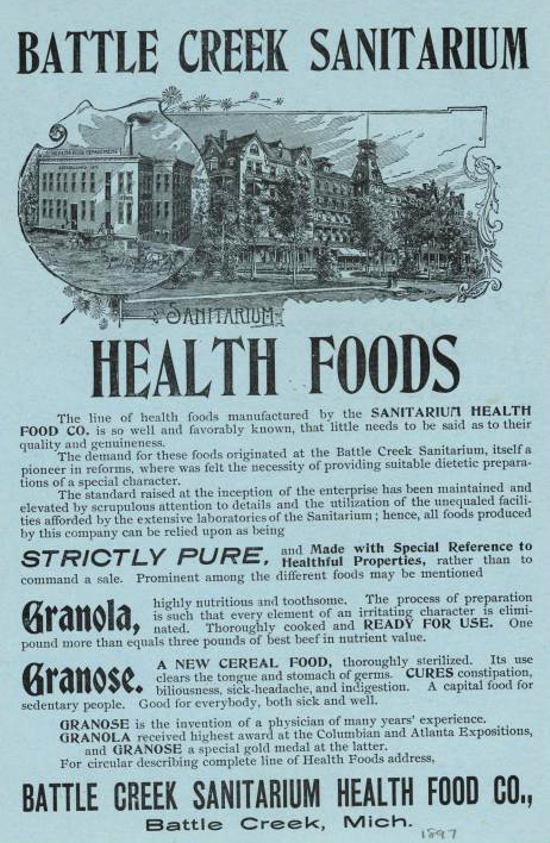A Wiki-Exploration of Cereal: the Quintessential American Breakfast Food
by Melissa Gu

For many decades now, American movies and commercials have featured images of cheerful households gathering together to enjoy a hearty breakfast as a family. Breakfast has become a part of American culture, with its reputation as “the most important meal of the day” surpassing a catchy phrase and becoming a fact in many people’s eyes.

What most people don’t know is that this seemingly innocuous saying actually originated as part of a 1944 marketing campaign by the cereal company General Foods (Mayyasi 2016). This campaign helped lead to the rise of cereal, establishing breakfast as a meal with distinct foods, and launching the ready-to-eat model of breakfast that remains to this day (Mayyasi).

An early cereal ad.
Cereal, from its early days of conception by men like John Harvey Kellogg, who believed that it would improve health and keep sexual desires low (Mayyasi), to modern times, where there are countless varieties for every age group and target audience, is both a testament to the power of advertisement as well as a fascinating subset of history. Long after cereal had strayed from its beginnings as an indigestion aid and turned into the sugary sweet snack we now know and love, Americans still considered it a health food, thanks to extensive marketing (Saxena 2018). Exploring the history of cereal and its meteoric rise can tell us about not only the evolution of American eating habits, but also changing attitudes in American society.

Cereal began strictly as a health food.
Pages in this corpus were selected from internal links of the Wikipedia page “List of Breakfast Cereals”. These pages include cereal companies such as Kellogg’s and Post, as well as pages for many individual cereals. The ordering of the pages begins with general pages such as “Breakfast Cereal” and “Brand”, followed by large food companies, and finally the many pages for individual cereals. Originally, the corpus included a multitude of unrelated pages about different cuisine types, locations, and various TV shows and franchises. These pages have been removed to keep the focus on cereals and the companies and brands that produce them. What follows is an exploration of some of the more noteworthy observations of the data displayed on the web pages generated from the corpus.
The “Breakfast Cereal” page revision history, specifically changes made to the first paragraph of the page, reflect an increased focus on health over recent years. While earlier versions of pages described cereal’s consumption as a breakfast food in any countries, beginning in 2009, the first paragraph began noting the high sugar content of many cereals, as well as the vitamin fortification process. Certain revisions, such as the 2011 version, note that high sugar content cereals are often marketed towards children with themes and free gifts included inside.
The “Brand” Wikipedia page is one of the longest of all of the pages, with the 2018 page revision containing 292,343 characters and 53 sections. This is as expected, as the topic is perhaps the broadest of all the pages in the corpus. It also contains a large number of internal links and images, likely for the same reason.
In contrast, the centrality values for the “Brand” page, as well as other broad pages such as “Store Brand” and “Trademark”, are very low. Although these are pages that tangentially relate to most or all of the other pages, the number of pages that actually link to these general pages are low, and therefore they have low centrality values.
The centrality values for the most general pages that are related to cereal, such as “Breakfast Cereal” and “List of Breakfast Cereals”, however, are among the highest of all the pages. This makes sense, as while these pages are broader, they are still closely related to many individual cereal pages, and thus would have many neighbors or links. Similarly, centrality values for the larger food companies such as Kashi, Keebler, and Kellogg’s are quite high, likely for similar reasons.
One interesting cluster of pages is the first cluster, which contains the large cereal and food brands, such as General Mills, Kellogg’s, Nabisco, Quaker Oats, and more, as well as the more general pages such as “Breakfast Cereal” and “Store brand”. These pages were likely clustered together due to their similar natures as brands or general concepts related to cereal that link to many of the specific cereal pages.
A trend that occurs in the revisions of many of the pages for individual cereals is the appearance of new section headers related to health. For example, the Cinnamon Toast Crunch page began to have a “Nutrition Facts” page in 2007, the Cocoa Krispies page began to have a “Health” section in 2015, and the Apple Jacks page added a “Nutrition” section in 2010. This addition to the Apple Jacks page corresponded with new packaging which noted that the inclusion of fiber was a change to the cereal. Anecdotally, it seems that in recent years the focus on the negative effects of sugar, the obesity crisis, and health has led to an increase in marketing of the health benefits of various food products, and these revisions may reflect this increased focus by food companies.
Another observation to note is that the original set of links chosen for the corpus resulted in many duplicated pages on the Docs page (which now have been removed). This is mostly due to various rebrandings and discontinuations, which caused certain pages to be removed and their links to redirect to other pages. For instance, the generic cereal company Malt-O-Meal Company recently rebranded to MOM Brands Company, causing links to the “Malt-O-Meal” page to redirect to the “MOM Brands” page.
Interestingly, the “List of breakfast cereals” page is only available in one language, despite being a fairly broad page. While cereal has expanded to become fairly popular around the world, it is still primarily a food eaten in Western cultures, especially the US. The page may be more specific to Western or even American cereals, which might explain why it is only available in one language.
A certain number of the pages contain very few sections, such as the Disney Mickey’s Magix and Disney Hunny B’s Honey-Graham pages. This is likely due to the fact that these cereals were fairly short lived and not particularly well-known. This does, however, raise the question as to why these pages were included in the original List of Breakfast Cereals page, as that page notes that it contains “notable” breakfast cereals.
Another page which has an interesting revision history is the Cheerios page. Beginning in 2009, the page contained section headers called “labeling controversy” or “2009 Drug Claim”, and the first paragraph began to detail a dispute with the FDA, which considered Cheerios an “unapproved new drug” due to its marketing and health claims. This was an instance where attempts to market a healthy cereal led to controversy, and the revisions certainly reflect that. Many other cereal pages include similar revisions for a multitude of controversies, including the Cocoa Krispies and Special K pages.

This controversial packaging claim began a dispute with the FDA.
The Kellogg’s page is available in 30 languages, which is a testament to the scale of the company and its long history. Another large cereal company, Post, which I would have considered to be a company of similar magnitude, is available in only one language. This difference may be partially due to the role of Kellogg’s namesake in turning cereal into the breakfast behemoth it is today, which cannot be said of Post.
The revisions for the “French Toast Crunch” page are interesting, as French Toast Crunch was discontinued and relaunched during the 2000s. The 2013 version was the first to include a “Discontinuation” section, and in 2014, the cereal was relaunched, prompting the renaming of the section as “Discontinuation and relaunch”.
Overall, all of the pages became longer throughout the years, demonstrating the expansion of knowledge available on Wikipedia over time. Many of the pages were also edited to include sections about health and nutrition throughout the late 2000s and early 2010s. In this way, Wikipedia revisions can reflect changing attitudes and shifts in values. As the focus began to shift towards a healthier cereal, the Wikipedia pages for various cereals reflected this change.